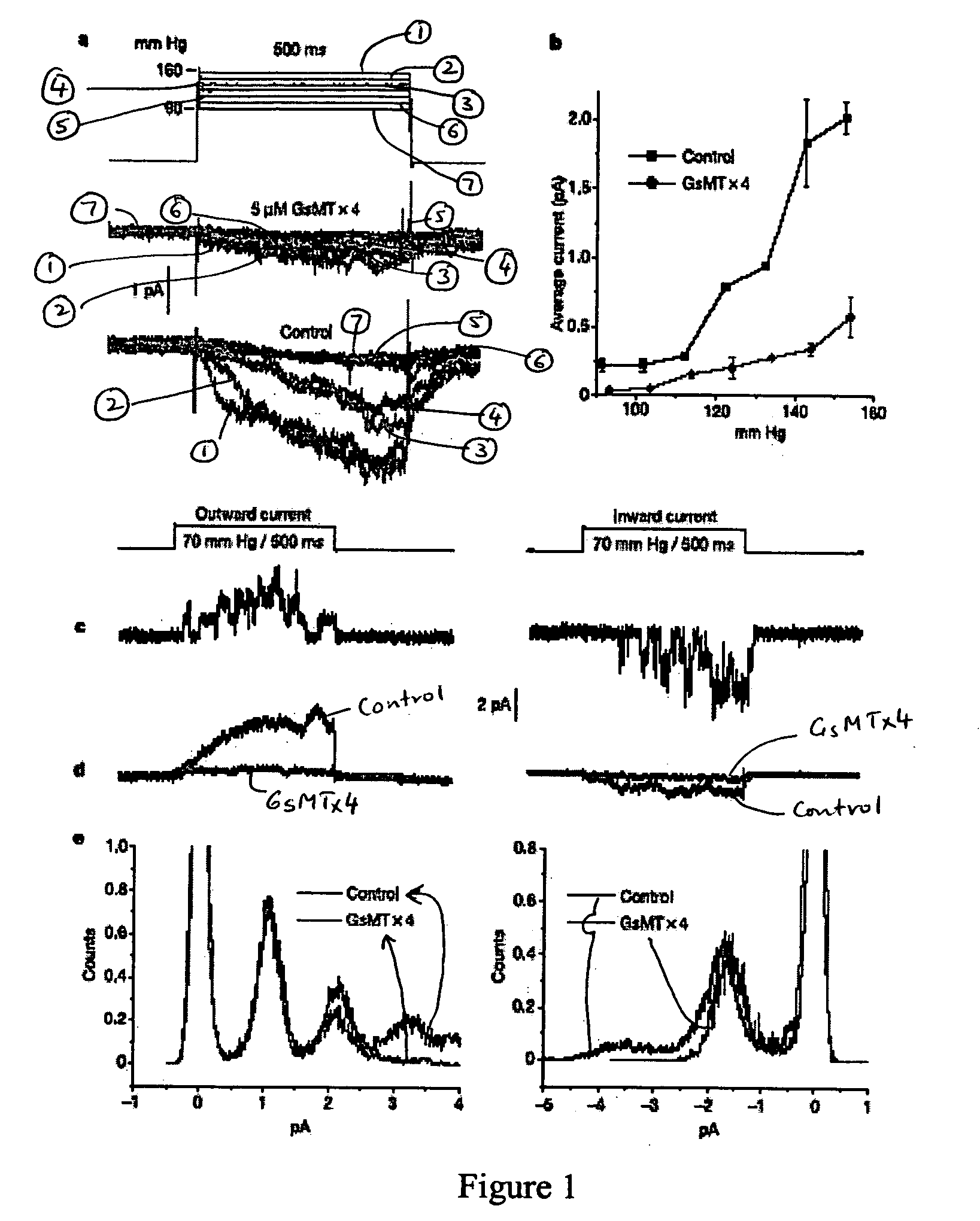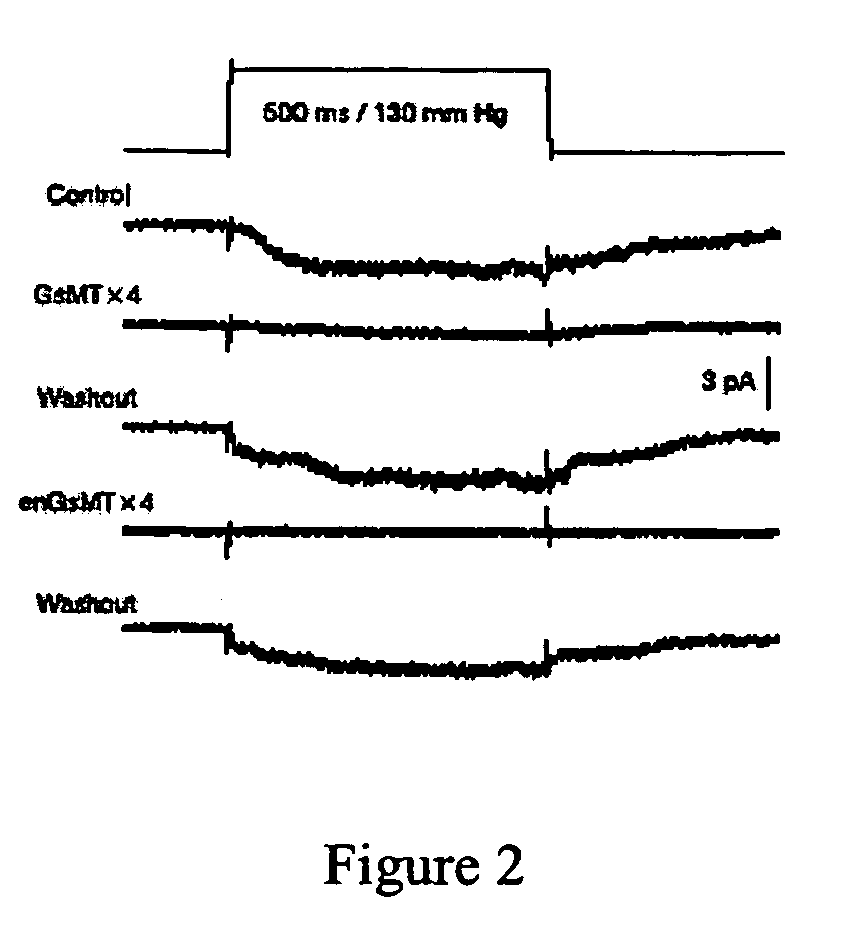Mechanically activated channel blocker
a technology of mechanical activation and blocker, which is applied in the field of peptides, can solve the problems of hampered development of sac-based approach to the treatment of arrhythmias, frequent sudden death of cardiac fibrillation, and inability to achieve etc., and achieves the effect of preventing cardiac fibrillation and preventing cardiac fibrillation
- Summary
- Abstract
- Description
- Claims
- Application Information
AI Technical Summary
Problems solved by technology
Method used
Image
Examples
example 1
[0027] This example describes the synthesis of D-GsMTx-4. The linear sequence of GsMTx4 having D amino acids was synthesized by SynPep. Purification and folding was performed as described for the L-form (Ostrow et al., Toxicon, 42, 263-274, 2003). The material (70% pure) (125 mg was dissolved in water and insoluble material was removed by centrifugation. The peptide was purified by RP-HPLC (reverse phase-high-performance liquid chromatography) (Zorbax 300 SB-C18, 9.4×250 mm column) with a 20% to 45% acetonitrile-water gradient, containing 0.1% triflouroacetic acid, at a flow rate of 3 ml / min (Trudelle et al., Int. J. Pept. Protein Res. 30, 163-169 1987). Elution was monitored at 220 and 280 nm; the desired peptide fractions were identified by MALDI-TOF (matrix-assisted laser desorption / ionisation-time of flight), pooled and evaporated to dryness. The purified peptide (200 μg) was dissolved in 800 μl water plus 100 μl 1M Tris at pH 8.0. For folding, 50 μl of reduced glutathione (5 mM...
example 2
[0028] This example describes the analysis of SACs in cultured cells
Methods
[0029] Primary reactive rat astrocytes cultures (passages 4 to 10) were prepared as previously described. Primary cultures of chick heart cells were prepared from 11-day-old embryos as previously described (Bett et al., J. Membr. Biol. 173, 237-254, 2000).
[0030] Outside-out patches were formed using pipettes containing 140 mM KCl, 2 mM MgCl2, 10 mM HEPES and 0.5 mM EGTA (as K salts). SAC currents were recorded using an Axopatch 200B patch clamp, with pClamp9 software and a Digidata 1322A acquisition system (Axon Instruments). Pressure was applied to the patch pipette with an HSPC-1 pressure clamp, and the patch was perfused using an ALA MP285 perfusion system (ALA Scientific Instruments). GsMTx4 or analog was dissolved in the perfusion solution: 140 mM NaCl, 10 mM Na-HEPES, 5 mM KCl, and 1 mM MgCl2. All experiments were repeated 0.2-3 times.
[0031] Fluorescence measurements were performed as described by ...
example 3
[0036] To examine whether GsMTx4 could alter SAC function through a purely bilayer-dependent mechanism, we synthesized D-GsMTx4 from D amino acids as described in Example 1, and tested its effect on SACs. Except for its optical properties, enGsMTx4 is indistinguishable from wild-type GsMTx4. The results shown in FIG. 2, indicate that both inhibit SACs. The effect seen with D-GsMTx4 was surprising because traditional models of protein-protein interaction are of the lock and key style, in which there are close steric interactions. A mirror image D enantiomer would not fit in the same lock as the L enantiomer, but in this case the effect is the same. The lack of chirality in protein-protein peptide effects is rare The D-forms inhibit SACs with similar efficacy to GsMTx4 (FIG. 2). Thus, GsMTx4 is unlikely to alter SAC gating by a lock-and-key mechanism, but, judging by the effects on conductance (FIG. 1e), the peptide is in close proximity to the channel.
PUM
| Property | Measurement | Unit |
|---|---|---|
| Stress optical coefficient | aaaaa | aaaaa |
Abstract
Description
Claims
Application Information
 Login to View More
Login to View More - R&D
- Intellectual Property
- Life Sciences
- Materials
- Tech Scout
- Unparalleled Data Quality
- Higher Quality Content
- 60% Fewer Hallucinations
Browse by: Latest US Patents, China's latest patents, Technical Efficacy Thesaurus, Application Domain, Technology Topic, Popular Technical Reports.
© 2025 PatSnap. All rights reserved.Legal|Privacy policy|Modern Slavery Act Transparency Statement|Sitemap|About US| Contact US: help@patsnap.com



